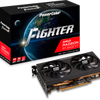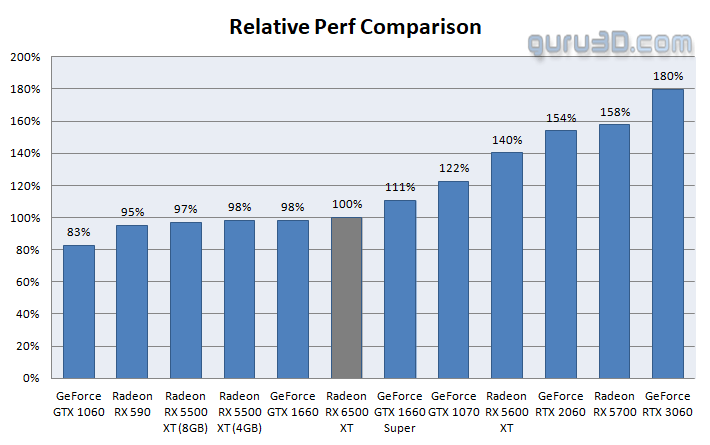Final words and conclusion
Final words
In case you didn't notice it, check the results again where the Radeon 5500 XT is listed in our charts. Released in December 2019, that card had a 8GB, a 128-bit wide memory bus and is performing roughly the same as today's tested product. it also had a starting price of $169. So yeah two years later the Radeon RX 6500 XT performs in that same entry-level class level with a 2% differential. Fun stuff when it comes to competitive low-level esport gaming, but now starting at 199 USD with realistic street prices to hit 250-300 USD. As far as I am concerned, this release is a bit of a cluster-frack as the wrong choices have been made. The memory bandwidth is extremely constrained at 64-bit, although the 16MB L3 cache compensates greatly until it runs out. The biggest limiting factor is the actual amount of graphics memory, you'll easily pass 4GB VRAM usage these days in any game and when that happens it all becomes a stuttering mess. Your only solution away from that is to lower image quality settings in-game in the form of AA and texture quality. The good news is that FSR is an option with this card, the bad news is that FSR works better at higher resolutions and not lower ones like Full HD.
Overall we strongly feel that this needs to be a 100-150 USD card, then AMD would have done well. This card at best offers reasonable Full HD gaming if the right conditions are met. You can expect prices to hit 250~300 USD for this entry-level graphics card, and that is a saddening fact. The Infinity cache (L3) works most of the time, it's designed to be a workaround to fill a massive weakness (the narrow 64-bit memory bus) and the choice of a more affordable memory type (GDDR6 opposed to GDDR6X), this AMD GPU is extremely memory bandwidth deprived, even with GDDR6 at 16 Gbps, due to the 64-bit wide memory bus. And that's going to bite this product in the ass every time you get GPU limited, or the 16MB L3 cache runs out and gets fewer cache hits.
Performance spread reference
Check out the following comparison of different graphics cards that are in a selected price-performance range. If you do not run into graphics memory limitations, here's where the card sits:
The card competes best with a GTX 1660 and with its own 5500 XT. Even the 5600 XT is already 40% faster. We'd also like to note that when on PCIe Gen 3.0 the x4 lanes limitation will inflict further performance reductions as shown in this article.
Cooling & acoustic
The Radeon RX 6500 XT delivers very decent cooling performance even under demanding situations, thanks to the dual-fan cooling. If you try to hear the card, you'll have a difficult time. According to its default configuration, the GPU beneath the hood generates 100W~120 of heat. We're looking at 36 DBa values under load and temperatures in the 60-65 degree Celsius range, which are both just ideal. Additionally, a board examination reveals that all-important components are linked to some sort of cooling. FLIR imaging reveals that the card is only barely leaking heat. In general, we are really satisfied with what we have observed.
Energy
Heat output and energy consumption are closely related to each other, as (graphics) processors and heat can be perceived as a 1:1 state; 100 Watts in energy consumption approaches close to 100 Watts in heat as output. This is the basis of TDP.
Coil whine
Coil squeal is hardly present on the 6500 XT, just as it is on any other card these days, albeit to a smaller extent than usual. Is it a bothersome annoyance? It is, without a doubt, at a volume that is difficult no concern. This type of noise would be muffled in a closed chassis and fade into the background. With an open chassis, on the other hand, you may hear coil whine/squeal. In some way or another, all graphics cards do this, especially when running at higher frame rates; this can be perceived.
Pricing
The bitter-sweet reality is that the market, needs cards like the Radeon RX 6500 XT very much, these are easy to fab cards with a low-value bill of materials. AMD is pushing it with 199 USD, but in these times with the current market, it's not an absurd value to ask. The problem then becomes expensive board designs from AIBs and then the asking price of the etailers. Early indications for this heavy bandwidth and VRAM limited graphics card for it to cost roughly 250-300 USD. And that's an absurd asking price for what this really is.
Tweaking
The RX 6500 XT enjoys having more memory bandwidth available to it. You can add it manually and get up to 18 or if you are lucky 19.2 Gbps; however, results will vary depending on the board, brand, and even card due to cooling (GDDR6/GPU/VRM) and other factors. With a little GPU tweaking, we could get this AMD Navi GPU to run at a very respectable ~2950 MHz. And that's without any anomalies or crashes of any kind. The dynamic clock frequency is now hovering in the 2800~2900 MHz range, depending on the load, game/app, and board assigned power. Even so, that's quite a feat. As is always the case, all of your tweaking and increased energy consumption will only provide you with a maximum of 5% improvement in performance (depending on your results and model graphics card).
Conclusion
The Radeon RX 6500 XT 4GB could have been a fun add-in card, but it's restricted in far too many ways. You can achieve low-level gaming with games that can manage the 4 GB VRAM graphics memory. For anything that passes 4GB, you'll need to select lower image quality settings to match max VRAM utilization and thus forfeit on rendering (image) quality. The narrow 64-bit memory bus is also a downright limiting factor, but the 16MB L3 infinity cache helps to bypass the deficits. Once the cache runs dry though, you're screwed and performance will cave in almost exponentially. Here again; only lowering image quality settings in-game will help you there. For an entry-level card, this still is or could be argued to be expected behavior. The 6500 XT's biggest limitation is the relatively small 4 GB graphics memory partition. Formula 1 2021, Witcher III, Hitman III, and Shadow of the Tomb Raider are all titles that will perform in a 50-60 FPS bracket on average at Full HD. But the second you hit a VRAM limitation or the cache is saturated, the performance will deteriorate. Also, be aware that running this card in PCIe Gen 3.0 will invoke another toll on performance due to its restricted x4 lane design, especially in situations where you get VRAM limited and the PCIe bus needs to access and fetch system memory at now half the bandwidth. In Full HD these days with modern games you'll quickly run out of VRAM. Would the card have been 100-125 USD, then I'd be okay with it as a compromise. However the MSRP is 199 USD, and we do know that these cards will end up in a 250~300 USD range. That IMHO is too steep. So choose, but choose carefully. The 4 PCIe links; preferably these are Gen 4.0 as on 3.0 another performance hit can be measured. For AMD fewer lanes mean fewer copper wires to bridge. It saves on the overall Bill of Materials, which is the same for the inferior choice in-memory configuration (4 GB). The Radeon RX 6500 XT IMHO would have been far better off even with 6 GB VRAM and a 96-bit bus, that or 8GB / 128-bit. AMD has made decisions in the memory subsystem that have limited memory bandwidth; by including 16MB of L3 cache, they have bypassed the majority of that memory bandwidth challenge, the card can perform decently up to 1920x1080; until the cache hits miss or VRAM runs dry. Because of the extremely limited memory bus, performance will suffer as soon as the cache fails to respond. The card has 16 Raytracing cores, you can play around with it and fool around with it at best as the setup is too weak to do anything else. All our raytracing tests demanded more than 4GB VRAM, so that's shot down as well. With these metrics and values, Raytracing is more of a gimmick really, a sticker on the box. The asking price continues to be a key source of concern also, particularly when considering the product's positioning and comparative performance. But that goes with anything that has a chip these days. In light of the pending GeForce RTX 3050 release from NVIDIA ( which has 8GB / 128 bit / x8 PCIe 4.0 lanes / DLSS) starting at $249 we see no reason to purchase this card in this price range. This card should have had 8 GB as default configuration, a 128-bit wide memory bus, and x8 PCIe lanes. We simply cannot recommend this if priced at street prices of 250-300 USD. The year 2022 just started, and this potentially looks to be the most insufficient graphics card series of the year.
Sign up to receive a notification when we publish a new article.
Or go back to Guru3D's front page.
- Hilbert, LOAD"*",8,1.


